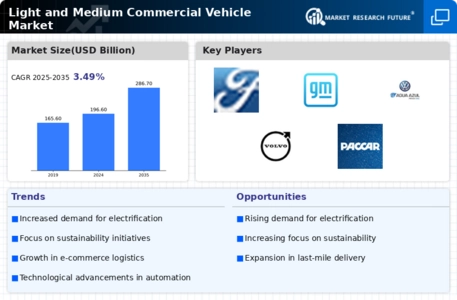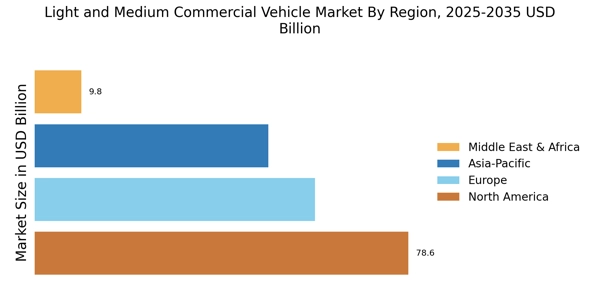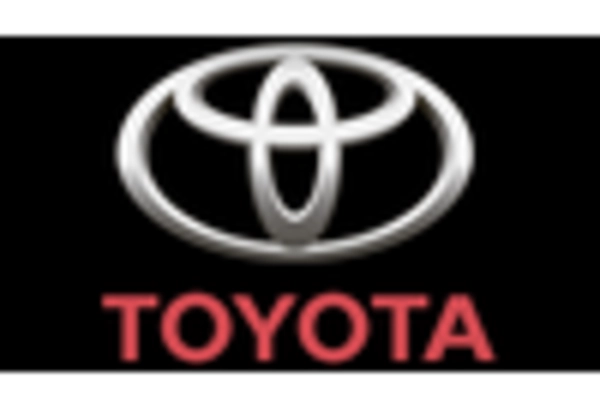Increasing Demand for Delivery Services
The rise in e-commerce has led to a notable increase in demand for delivery services, which directly impacts the Light and Medium Commercial Vehicle Market. As consumers increasingly prefer online shopping, businesses are compelled to enhance their logistics capabilities. This trend is reflected in the projected growth of the last-mile delivery segment, which is expected to expand significantly. The need for efficient delivery solutions drives the demand for light and medium commercial vehicles, as they are ideally suited for urban environments where maneuverability and fuel efficiency are paramount. Consequently, companies are investing in their fleets to meet consumer expectations, thereby propelling the Light and Medium Commercial Vehicle Market forward.
Regulatory Support for Emission Reductions
Governments worldwide are implementing stringent regulations aimed at reducing vehicle emissions, which is influencing the Light and Medium Commercial Vehicle Market. These regulations often encourage the adoption of cleaner technologies, such as electric and hybrid vehicles. As a result, manufacturers are increasingly focusing on developing low-emission models to comply with these standards. The market for electric light commercial vehicles is projected to grow, driven by incentives and subsidies provided by various governments. This regulatory landscape not only fosters innovation but also enhances the competitive edge of companies that adapt to these changes, thereby shaping the future of the Light and Medium Commercial Vehicle Market.
Urbanization and Infrastructure Development
Rapid urbanization is reshaping transportation needs, significantly impacting the Light and Medium Commercial Vehicle Market. As cities expand, the demand for efficient transportation solutions increases, particularly for goods delivery and services. Infrastructure development, including improved road networks and logistics hubs, facilitates the movement of commercial vehicles. This trend is evident in emerging markets, where urban centers are experiencing substantial growth. The need for versatile vehicles that can navigate congested urban areas is driving manufacturers to innovate and adapt their offerings. Consequently, the Light and Medium Commercial Vehicle Market is poised for growth as urbanization continues to influence logistics and transportation dynamics.
Technological Integration in Fleet Management
The integration of advanced technologies in fleet management is transforming the Light and Medium Commercial Vehicle Market. Technologies such as telematics, GPS tracking, and route optimization software enhance operational efficiency and reduce costs for businesses. These innovations allow companies to monitor vehicle performance, manage fuel consumption, and improve delivery times. As businesses seek to optimize their logistics operations, the demand for vehicles equipped with these technologies is likely to increase. This trend not only improves the overall efficiency of the fleet but also contributes to the sustainability goals of companies, thereby driving growth in the Light and Medium Commercial Vehicle Market.
Shift Towards Sustainable Transportation Solutions
There is a growing emphasis on sustainability within the transportation sector, which is influencing the Light and Medium Commercial Vehicle Market. Companies are increasingly seeking to reduce their carbon footprint and enhance their corporate social responsibility profiles. This shift is prompting investments in alternative fuel vehicles, such as electric and hydrogen-powered models. The market for these sustainable vehicles is expected to expand as businesses recognize the long-term benefits of adopting greener technologies. Additionally, consumer preferences are shifting towards companies that prioritize sustainability, further driving the demand for eco-friendly light and medium commercial vehicles. This trend is likely to shape the future landscape of the Light and Medium Commercial Vehicle Market.


















Leave a Comment